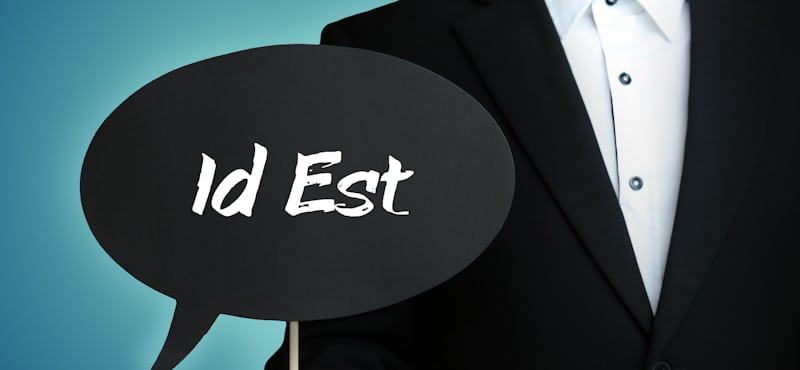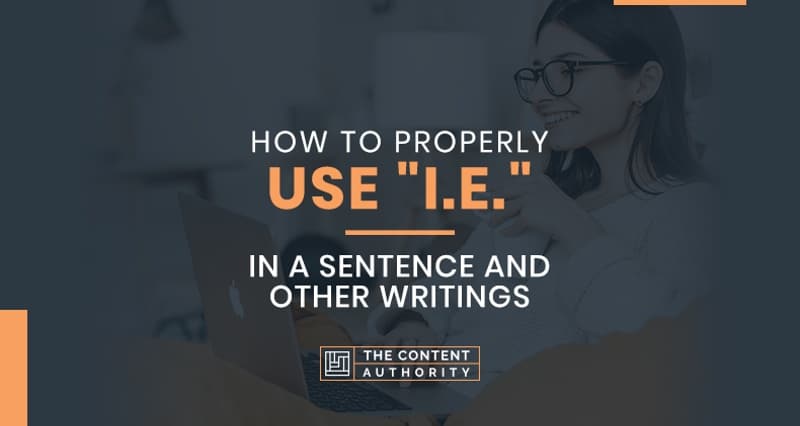Modern English is awash with abbreviations. And the irony is that more than a handful of them are not based on actual English words. Such usage of abbreviations based on foreign words—for instance, “i.e”—has befuddled many an English language expert, with the majority not knowing how to use those truncated word forms in sentences and other forms of writings.
To properly use “i.e” in a sentence, write the two letters in lowercase. Put it anywhere, but right at the beginning or end of a sentence. Also, place a period (.) after the two letters “I” and “e”. There must be a comma after the second full stop too, along with one before the abbreviation.
To correctly use “i.e” in a sentence, you should have a clear, complete understanding of the abbreviation. Keep reading to learn pretty much everything there is to know about “i.e.” and how to use the abbreviation in a variety of sentences and writing situations.
“i.e.” – Definition
“I.e.” is a Latin abbreviation that stands for “id est”, which means “in other words.” “In essence” is another English translation or expansion for the letters “I” and “e”. The abbreviation is typically used to introduce a rephrase or elaboration of an already stated point in the sentence. Typically, a metaphor, clarification, or definition follows the abbreviation.

How to Properly Use “i.e.” in a Sentence?
The very first and basic rule to remember when using “i.e.” in a sentence is to not italicize it – even though it’s based on the Latin words “id est”, which gets the italicized treatment in written English.
The abbreviation “i.e.” has been in use in scholarly and standard English writings for so long and so extensively that there’s no need for any italicization or bolding. In a sentence, the abbreviation “i.e.” should be capitalized only if it shows up at the start of a sentence (which is rare and also usually grammatically incorrect).
While “i.e.” is typically set off by parentheses or brackets, it could at times follow an em dash (—) or a comma. Using a comma before “i.e.” in a sentence is, in fact, quite common. An em dash is used if “i.e” introduces dramatic thoughts or ideas. A colon (:) could also be used before “i.e.”.
- Mary carried just the basic items, i.e., business cards, pepper spray, lipstick.
- Mary carried just the essentials—i.e., business cards, pepper spray, lipstick.
- Mary carried just the basics: i.e., business cards, pepper spray, lipstick.
In certain writing styles – for instance, the Chicago Manual of Style – “i.e.” may be considered inappropriate and the abbreviation, therefore, is allowed only in parentheses.
- I was grounded (i.e., no phone or TV) because I reached home extremely late.
In the above sentence, “i.e.” and the additional information after it is set off using parentheses as it interrupts the sentence’s flow.
Using a Comma with “I.e.”
A comma typically follows the abbreviation but it’s also not rare to see “i.e.” without a comma after it. Certain spellcheckers may, in fact, would prompt you to remove the punctuation.
Generally, a comma is not placed after “i.e.” in UK English, thanks to multiple British style guides – such as Modern English Usage by Henry Fowler – prescribing against it. In American English, however, a comma after “i.e.” is a lot more common and acceptable.
If you, at any point during your writing, believe there should be no comma after the abbreviation, do so at your own risk. Each time you are split between using the comma and not using it, go with the comma.
The combination of parentheses and comma is typically used in formal writing – such as in essays and company letters. In not-so-formal writing scenarios, using parenthetical commas is standard practice.
A Quick Recap
Here is a quick summary of the things discussed above:
- Each letter should have a period after it (“i.e.”, and not “ie” or “i.e”).
- The first letter should be capitalized if the abbreviation is being used at the start of a sentence.
- The abbreviation need not be “italicized” or “bolded“.
- A comma should always follow “i.e.” if it’s not at the end of a sentence.
Example Sentences with “i.e.”
The following are sentences with the abbreviation “i.e.” in them. Kindly note, the punctuation around “i.e.” is not the same across sentences.
- Besides crossword puzzles and writing, I love touring on my bike, i.e., travel several hundred miles on my bicycle lugging all my camping equipment.
- The cough could last for a brief period—i.e., a couple of days.
- If you are being supplied with “hard water” (i.e., very high mineral content) in your house, you shouldn’t be surprised to see yellow or white residue build-up in your tubs.
- I shall review the sales team presentation slides and let you know my feedback at the earliest – i.e., in a day or two.
- Every student of genetics learns the two fundamental approaches in the area, i.e., reverse genetics, and forward genetics.
- I am a non-vegetarian, i.e., I have no issues consuming meat.
- Jerry works the evening shift, i.e., from 6 pm to 2 am.
- He likes to write poetry about love, i.e., poetries that deal with matters relating to the heart.
- On Fridays, I wear casuals to work, i.e., a pair of jeans and a polo shirt.
- We got rid of the shirt from the next season’s catalog as our customers alerted us of a major quality problem with the product (i.e., the blue hue was not colorfast).
- The hotel provides turndown service, i.e., the bed and pillow for your night’s sleep will be duly and professionally done by the maid.
- Amy was enthused to receive a gift from Tim, i.e., her secret admirer.
The Difference Between “i.e.” and “e.g.”
Many English language writers, including native speakers, confuse between “i.e.” and “e.g.” time and again. Both the abbreviations are used with similar functions, in similar scenarios – following a category or noun and preceding another list or noun. Therefore, the confusion between the two even among the most conscientious writers is not very surprising.
The abbreviation “e.g.” stands for “exempli gratia” which is translated as “for example” in English. “E.g.” is used to introduce a limited number of examples (not an entire list). “I.e.”, on the other hand, denotes more precise information. In other words, “e.g.” opens up options; “i.e.” narrows things down.
- After school, I’ll be playing video games, i.e., Fortnite with my cousins.
- After school, I’ll be playing video games, e.g., Fortnite, Minecraft, and Grand Theft Auto.
The first sentence above clearly states what game the subject will play and with whom. The second sentence, on the other hand, lists out the games. Since “e.g.” doesn’t indicate a complete list, it’s safe to assume the subject could be planning to play more titles than just the three mentioned.
Here are a couple more sentences to drive home the point:
- Michael loves watching the nephews of Donald Duck (i.e., Dewey, Huey, and Louie).
- Michael loves watching classic cartoons (e.g. Tugboat Mickey and DuckTales).
Learning to Remember “i.e.” and “e.g.”
If you are having trouble remembering the difference between the two abbreviations, learn some memory tricks. In other words, learn to associate the letters of the two contractions with a certain pattern.
Consider the letter “I” at the start of “i.e.” standing in for the opening word in “in other words”. With “e.g.”, remembering things is a little less complex as “e” stands for “exempli”, which means “example”.
Kindly note, it’s not always mandatory to use the two abbreviations. They are predominantly used for writing convenience and speed. If you think you are not getting the abbreviations right in certain scenarios—perhaps you’re not sure about the punctuations around them or their actual placement—you can always use the phrases “in other words” or “for example” instead.
“i.e.” and “e.g.” Cannot Be Used Interchangeably
While “i.e.” and ‘e.g.” seem like they could be used interchangeably, doing so could be considered blasphemy by the purists.
- The European countries (i.e. Finland, Sweden, and Norway) were doing quite well economically.
- The European countries (e.g. Finland, Sweden, and Norway) were doing quite well economically.
In the first sentence, “i.e” is expanding on or elaborating the phrase “European countries”, giving the reader a clear understanding of the countries doing good economy-wise in the continent. It’s safe to assume that only the three countries mentioned were doing well and other European nations not so.
The second sentence with “e.g.” supposedly indicates the three countries are among the multiple European countries faring well. Since the abbreviation “e.g.” denotes a non-exhaustive list, the reader would assume there were more countries in Europe that did well with their economy.
This is exactly the reason why it’s imperative to not confuse between the two abbreviations at any point during your writing.
Conclusion

The abbreviation “i.e.” is extremely common and is extensively used in formal write-ups. However, you could also use it in less-formal settings, such as when writing a letter or email to a friend or relative. Just make sure the person at the receiving end of the message knows what the abbreviation “i.e.” means or stands for.
As mentioned above, using “i.e.” in formal writing situations is perfectly normal. However, there could be instances when you could be better off using the phrase “in other words” or “that is”. Confirm if it’s appropriate to use the abbreviation with your instructor or manager before using it in your essays or emails.
Needless to say, the rules regarding the usage of “i.e.” are all over the place and vary with the writing style or language variant you follow.
Shawn Manaher is the founder and CEO of The Content Authority. He’s one part content manager, one part writing ninja organizer, and two parts leader of top content creators. You don’t even want to know what he calls pancakes.


